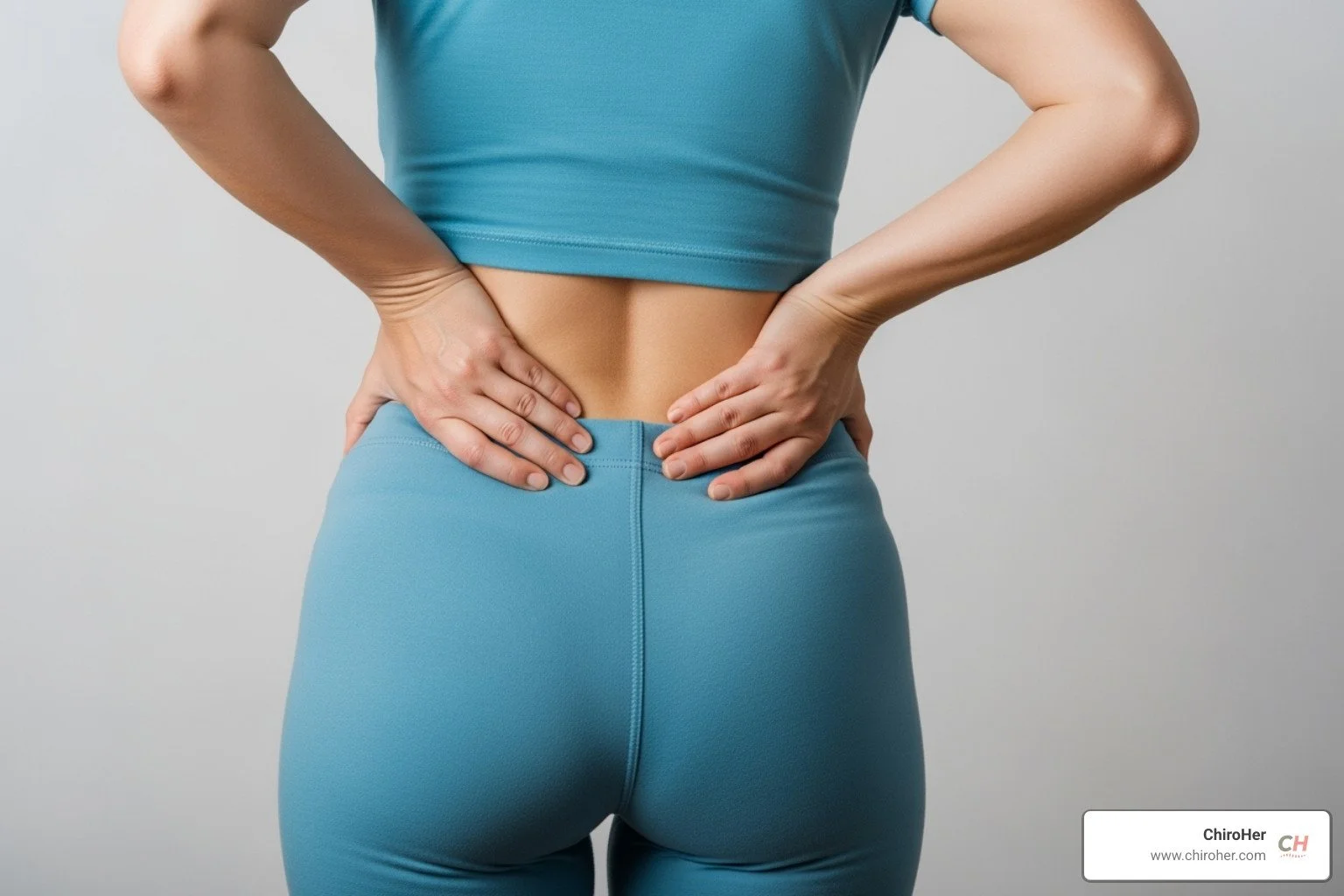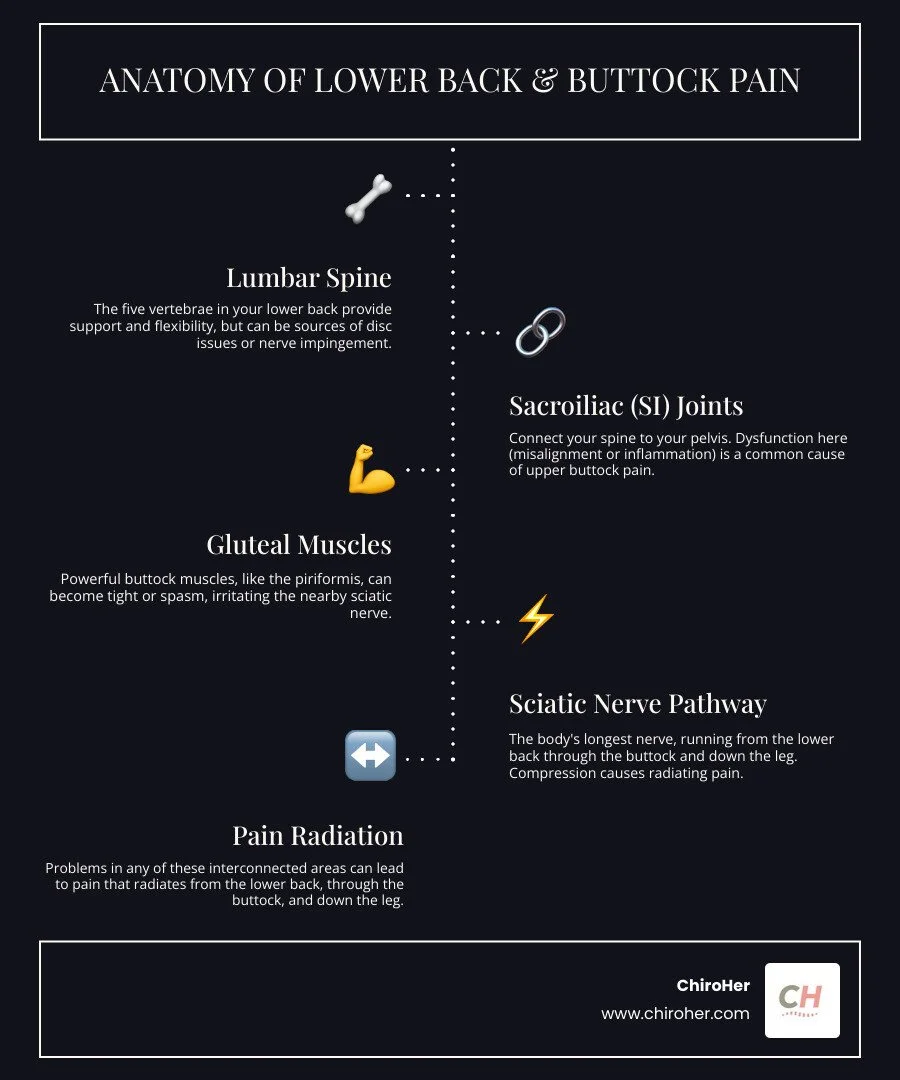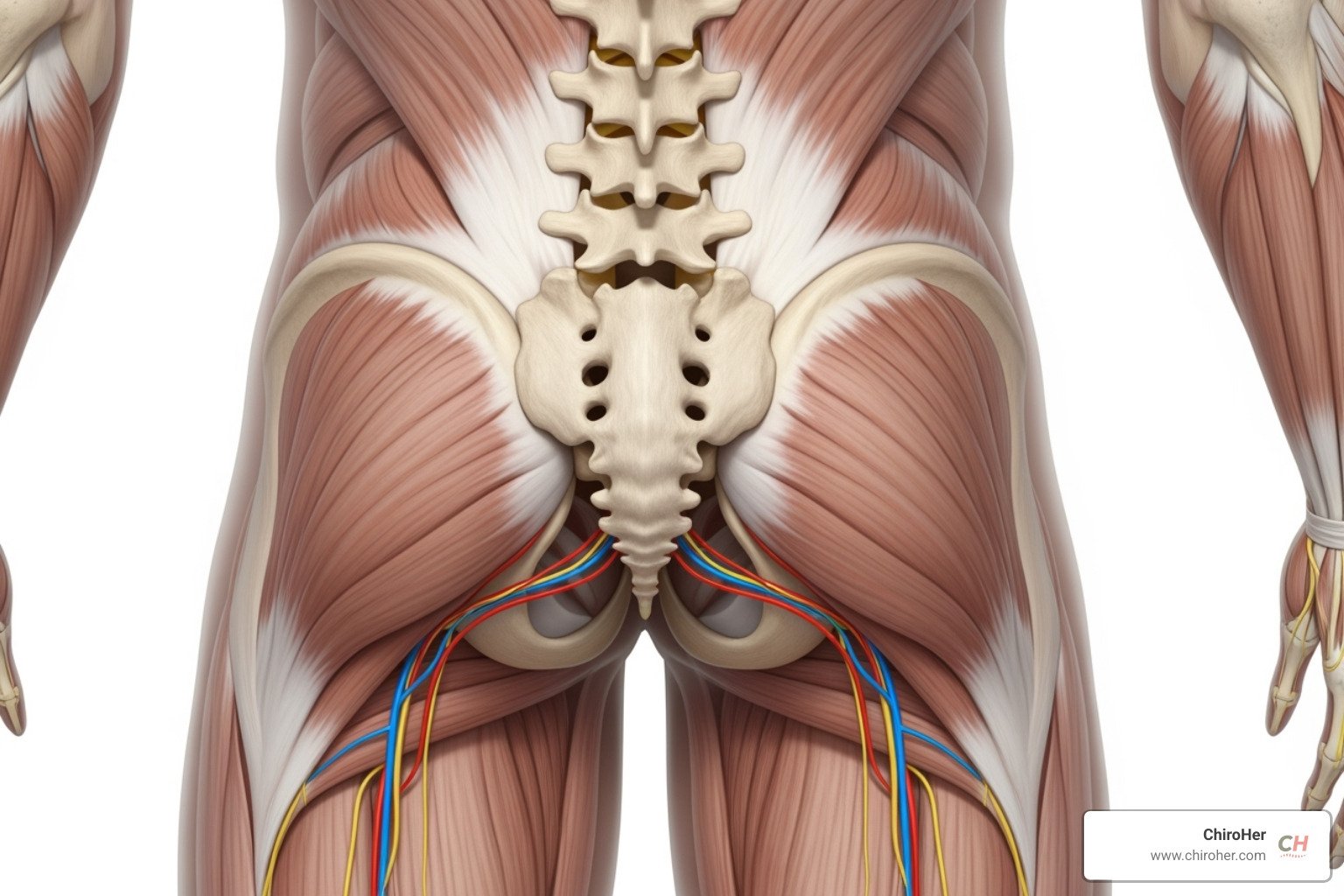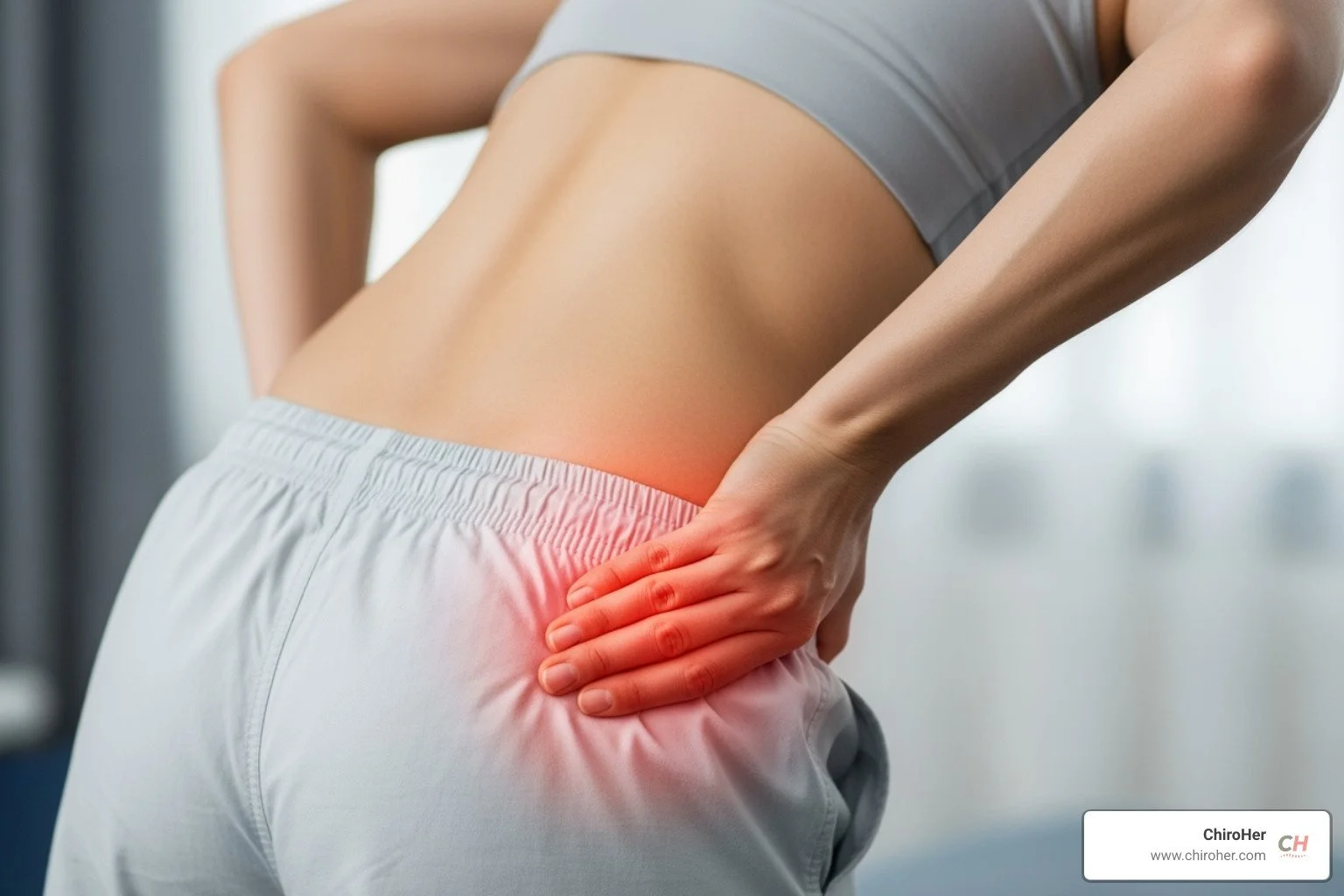Finding Relief: What Your Lower Back and Upper Buttock Pain Means
Why Lower Back and Upper Buttock Pain Deserves Your Attention
Lower back upper buttock pain is more than an inconvenience; it's a signal from your body that something needs attention. You're not alone in this experience. Studies show that about 84 percent of adults report having lower back pain at some point in their lives, affecting everything from sitting at a desk to playing with kids.
Quick Answer: What Causes Lower Back Upper Buttock Pain?
The most common causes include:
Muscle strain or ligament sprain from lifting, twisting, or sudden movements
Sciatica - compression of the sciatic nerve causing radiating pain
Sacroiliac (SI) joint dysfunction - inflammation or misalignment of the joints connecting your spine to your pelvis
Piriformis syndrome - a muscle in your buttock pressing on the sciatic nerve
Herniated disc - a spinal disc pressing on nearby nerves
Spinal stenosis - narrowing of the spinal canal (more common over age 60)
This area is prone to pain because of its interconnected anatomy. Your lower back, pelvis, gluteal muscles, and the sciatic nerve all work together. When one part isn't functioning correctly, it can create a cascade of problems.
Hi! I'm Dr. Michelle Andrews, and I've spent years helping Oklahoma City women find lasting relief from lower back upper buttock pain through personalized chiropractic care. I specialize in identifying the root cause of your discomfort—not just masking symptoms—so you can get back to the activities you love.
Understanding the Source of Your Lower Back and Upper Buttock Pain
Think of your lower back and buttock area as a busy intersection. When there's a problem at this junction, it affects everything downstream. Your lumbar spine (lower back) supports most of your body's weight, with cushiony discs between each vertebra. The sacroiliac (SI) joints connect your spine to your pelvis, transferring weight to your legs. Your gluteal muscles power movement, and deep within them lies the piriformis muscle. Running through this area is the sciatic nerve, the longest nerve in your body. When any of these structures are compromised, pain can result. Sometimes the issue is a misaligned pelvis, which can throw the entire system off balance.
What Are the Common Causes of Pain Just Above the Buttocks?
When you feel that ache just above your buttocks, one of these issues is often the culprit. For a broader look at what causes back pain, we've covered the topic in detail.
Muscle strains and ligament sprains: These are the most frequent causes, often resulting from lifting something heavy, twisting awkwardly, or even sleeping in an odd position. You'll feel localized pain, stiffness, and tenderness.
Sacroiliitis: This is inflammation of your SI joints, creating pain in the buttocks and lower back. It often worsens when standing, climbing stairs, or running. The Spine-Health resource on sacroiliitis offers more insight.
Herniated disc: This occurs when a spinal disc's soft center pushes through its outer layer, pressing on nearby nerves. This can cause pain that radiates into your buttock and down your leg. The AANS provides comprehensive information on this condition.
Spinal stenosis: This is a narrowing of the spinal canal, which puts pressure on nerves. It's more common after age 60 and can cause pain, numbness, or weakness. The Mayo Clinic offers detailed information on spinal stenosis.
Pelvic girdle pain: This is common during and after pregnancy due to hormonal and physical changes affecting pelvic joint stability.
Other risk factors include excess weight, a sedentary lifestyle, and poor posture. For women, conditions like endometriosis or uterine fibroids can cause referred pain to this area. Kidney issues, like kidney stones, can also be a source.
What is Sciatica and How Does it Cause Pain?
Sciatica isn't a condition itself, but a symptom of an underlying issue that irritates the sciatic nerve. People often describe it as a sharp, shooting pain that starts in the lower back or buttock and travels down one leg. You might also feel numbness, tingling, or muscle weakness. The most common causes are herniated discs and bone spurs. The good news is that up to 90% of people with sciatica recover without surgery. For a thorough explanation, see our Sciatic Nerve Pain Complete Guide or information from the Mayo Clinic on sciatica.
Piriformis Syndrome vs. Sciatica: What's the Difference?
Piriformis syndrome and sciatica feel very similar, but their origins differ. Sciatica is a general term for sciatic nerve pain, usually caused by a spinal issue like a herniated disc. Piriformis syndrome is more specific: it happens when the piriformis muscle in your buttock spasms and compresses the sciatic nerve directly.
The pain from piriformis syndrome often feels deeper in the buttock and worsens with prolonged sitting, walking, or climbing stairs. Sciatica from a spinal issue might be aggravated by coughing or bending forward. Distinguishing between them is key to effective treatment. For more information, visit our page on discomfort in buttocks or see resources from the Cleveland Clinic and NCBI.
Feature Sciatica (General) Piriformis Syndrome Primary Cause Spinal issues (herniated disc, spinal stenosis) Piriformis muscle spasm or tightness compressing the nerve Pain Location Lower back, buttock, and down the leg Deep buttock, radiating down the back of the leg Aggravating Factors Sitting, coughing, sneezing, bending forward Prolonged sitting (especially on hard surfaces), walking, running, climbing stairs, hip-flexed positions Nerve Involvement Sciatic nerve roots at the spine Sciatic nerve in the buttock region
Pathways to Relief and Professional Care
Once we understand the source of your lower back upper buttock pain, we can create a plan for relief. Most people feel better with a combination of professional care and at-home strategies. My goal is to help you get back to your life, free from discomfort.
How Chiropractic Care Can Address Lower Back Upper Buttock Pain
At ChiroHer, we focus on addressing the root cause of your pain, not just the symptoms. Our approach includes several effective techniques.
Spinal Adjustments: We use gentle, precise movements to correct misalignments in your spine and pelvis. This takes pressure off pinched nerves and helps your joints move correctly. Many patients feel immediate relief. Learn more about Spinal Manipulation and how chiropractic helps back pain.
Manual and Soft Tissue Therapy: We use hands-on techniques like deep tissue massage and myofascial release to relax tight muscles in your lower back and buttocks, improving blood flow and releasing trapped nerves. Our Manual Therapy guide explains more.
Reducing Nerve Pressure: Our treatments aim to create more space for compressed nerves, which can significantly reduce shooting pain, numbness, and tingling. If you're wondering can a chiropractor help a pinched nerve, the answer is often yes.
Holistic Guidance: We look at your whole lifestyle, from workplace ergonomics to stress levels, and provide therapeutic exercises and advice to support your recovery and prevent future issues.
At-Home Strategies and Supportive Therapies for Relief
What you do at home is just as important as professional care. These simple strategies can help you manage lower back upper buttock pain.
Core Strength and Flexibility: Building core strength provides natural support for your spine. Gentle flexibility exercises and Therapeutic Exercises can ease muscle tightness and are a cornerstone of recovery.
Posture Improvement: Maintaining a neutral spine while sitting and standing reduces pressure on your spinal column and nerves. Healthline has great advice on correcting your posture.
Heat and Ice Therapy: Ice can calm acute inflammation in the first 48 hours of a flare-up, while heat helps relax tight muscles afterward. WebMD offers guidance on using heat and ice therapy.
Gentle Stretching: Incorporate daily stretches to relieve tension. Move slowly and never force a movement that causes sharp pain. Healthline has an excellent resource on lower back stretches. Good options include:
Knee-to-chest stretch
Seated twist or pretzel stretch
Figure-four stretch
Cat-cow stretch
Child's pose
Hamstring stretches
When to Seek Professional Medical Help
While most cases improve with conservative care, some symptoms require immediate medical attention. Please seek help if you experience any of the following:
Sudden numbness or muscle weakness in one or both legs
Loss of bladder or bowel control
Numbness in the "saddle area" (groin, inner thighs)
Severe pain after a major injury (car accident, bad fall)
Pain that continuously worsens or doesn't improve after a few weeks
Unexplained weight loss or fever accompanying the pain
A history of cancer, recent surgery, or use of immunosuppressants or blood thinners
The Journal of the American Academy of Physician Assistants provides a comprehensive overview of these red flag symptoms. If you have any of these symptoms, or if your pain is significantly affecting your life, please don't wait. Contact Us Oklahoma City to schedule an assessment.
Building Trust: Why Choose ChiroHer for Your Back and Buttock Pain
When you're dealing with lower back upper buttock pain, finding a provider who understands your unique needs is critical. At ChiroHer, we've built our practice on providing care that's as unique as you are.
Hi! I'm Dr. Michelle Andrews, and I founded ChiroHer to create a different kind of chiropractic experience. Our award-winning team specializes in treating musculoskeletal conditions, with a focus on the issues affecting women and prenatal clients. We understand the anatomical and hormonal changes that can contribute to pain and are here to support you.
What sets us apart is our commitment to patient-centered care in an upscale, comfortable clinic. We take the time to listen and perform thorough assessments to develop a treatment plan that fits your goals. Our licensed professionals use evidence-based care, combining chiropractic adjustments with manual therapy, therapeutic exercises, and lifestyle guidance. This comprehensive approach is supported by organizations like the American Chiropractic Association and research from sources like the Mayo Clinic on Back Pain.
Whether you're in Oklahoma City, Yukon, Edmond, Nichols Hills, Del City, Mustang, or Moore, our team is ready to help you find relief. Our goal is to help you feel better now and give you the tools to maintain your health for years to come.
Ready to take the next step? You can Schedule a Consultation or Book Now through our website. To learn more, explore our Chiropractic Care services or visit our Back Pain Category for helpful resources. We look forward to helping you live a life free from pain.
This guide is for informational purposes and is not a substitute for already established medical advice from your healthcare provider.





